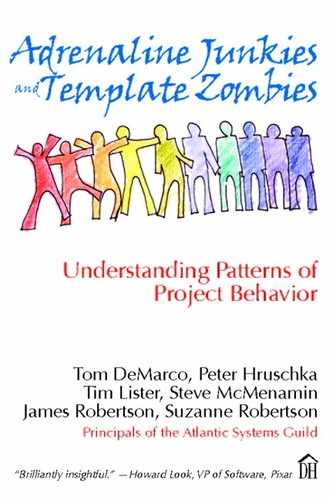37. Talk Then Write
,
The project team makes decisions during conversations, and then immediately communicates the decisions in writing.
At first reading, this may appear to be nothing more than a statement of the obvious: When you conduct a meeting, you should distribute minutes afterward. We might also conclude it was obvious if we didn’t see so many teams operating differently, and suffering for it.
When it comes time to make a decision, you want to do it well and you want to do it quickly. Time is short on development projects. Sometimes, making a decision is on the critical path; resources are blocked, or will soon become blocked, until a decision is reached. More often, decisions are made before they drive the critical path, but they still need to be made quickly, simply because there are so many things to do and so many other decisions to make.
Conversation is the best medium for reaching good decisions quickly. Well-structured conversations bring minds together in an intense, high-bandwidth exchange. You tap the experience and intelligence of multiple team members, over a short period of time, to arrive at a decision that is informed by many perspectives. Unlike meandering e-mail threads, effective conversations work because they are synchronous; parties engage continuously until a decision is reached.
Once a decision is reached, it is time to change gears. You want to communicate the decision you have made, clearly and durably, to all those affected by it. This strategy is hardly new. These are some of the requirements that inspired the Sumerians to invent writing, more than 5,000 years ago. They had long conducted sales and other negotiations through conversation, but they were looking for a more effective way to preserve the results of these commercial and legal transactions. In response, they developed the early writing systems that later evolved into cuneiform.
What worked in the markets and temples of Mesopotamia still has something valuable to offer your twenty-first century projects: Writing persists in a way that memories of conversations do not. Communicating a decision in writing preserves the decision-making conversation for those who were not present and for those who have forgotten its details.
The benefits of intense conversations and clear prose are so obvious that you have to wonder why all teams don’t use both methods, selecting whichever one works best in a given situation. A team’s communication preferences tend to reflect those of the organization of which it is part, and each organization’s culture affects its communication styles. Bigger, more formal organizations tend to rely more on writing. Smaller, more nimble organizations tend to rely more on face-to-face conversations, telephone calls, and less durable forms of writing, such as instant messaging. Teams in such organizations fall into the habit of relying—too much—on whichever form of communication most easily fits their culture.
Teams in small companies often are quite effective at making decisions: They have a strong culture of using brief, intense, ad hoc meetings for addressing tough issues and plotting solutions. But their cultures are so rooted in oral communication that they attempt to use this same approach to communicate decisions. They’re so comfortable with oral communication that they don’t realize when switching gears makes sense.
Failure to switch gears is even easier to see in the case of large companies or distributed teams. When a project team is distributed across large distances, e-mail is often its principal means of communication. Team members can become so comfortable working out of their In boxes that they think nothing of posing a question for decision via e-mail. A dialogue ensues, often with more and more people added to the “CC” line, and what could have been decided in one or two brief meetings stretches across days of debate, without resolution.
The most effective teams have the discipline to employ less culturally comfortable forms of communication when they are the best-suited to the task at hand. Even in the most formal companies, rapid and effective decision-making is done through conversation. And even in the fleetest start-ups, communication of durable decisions is written.
